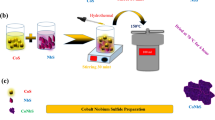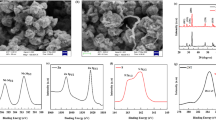Abstract
Tremendous efforts have been devoted to develop the active materials for supercapacitor electrodes, but very few are focused on the improvement of the electrode material/electrolyte interfaces via protonic conductors. In this study, double conductive networks are constructed in powdery carbon electrodes by using sulfated zirconia as protonic conductor and acetylene black as electric conductor. The synergetic effect of protonic and electric double transport pathways enhances the electrode material/electrolyte interfaces, reduces diffusion distance of protons, and increases the electrode specific capacitance. Compared to the control electrode without protonic conductor, the electrode shows a specific capacitance with 21.0% increment. The proposed strategy may be a promising avenue for preparation of powdery carbon electrodes used in electrical double-layer capacitors.

Double conductive networks in powdery carbon electrodes constructed by sulfated zirconia as protonic conductor and acetylene black as electric conductor




Similar content being viewed by others
References
Zhang H, Shen PK (2012) Recent development of polymer electrolyte membranes for fuel cells. Chem Rev 112:2780–2832
Shao Y, El-Kady MF, Sun J, Li Y, Zhang Q, Zhu M et al (2018) Design and mechanisms of asymmetric supercapacitors. Chem Rev 118:9233–9280
Wang Y, Song Y, Xia Y (2016) Electrochemical capacitors: mechanism, materials, systems, characterization and applications. Chem Soc Rev 45:5925–5950
Wei L, Sevilla M, Fuertes AB, Mokaya R, Yushin G (2012) Polypyrrole-derived activated carbons for high-performance electrical double-layer capacitors with ionic liquid electrolyte. Adv Funct Mater 22:827–834
Sun W, Lipka SM, Swartz C, Williams D, Yang F (2016) Hemp-derived activated carbons for supercapacitors. Carbon. 103:181–192
Deng W, Kang T, Liu H, Zhang J, Wang N, Lu N et al (2018) Potassium hydroxide activated and nitrogen doped graphene with enhanced supercapacitive behavior. Sci Adv Mater 10:937–949
Li M, Xue J (2014) Integrated synthesis of nitrogen-doped mesoporous carbon from melamine resins with superior performance in supercapacitors. J Phys Chem C 118:2507–2517
Gao F, Qu J, Zhao Z, Wang Z, Qiu J (2016) Nitrogen-doped activated carbon derived from prawn shells for high-performance supercapacitors. Electrochim Acta 190:1134–1141
Silvia R, Clara B, Marcos G, Rosa M, Ricardo S (2011) Towards a further generation of high-energy carbon-based capacitors by using redox-active electrolytes. Angew Chem Int Ed 50:1699–1701
Wu J, Yu H, Fan L, Luo G, Lin J, Huang M (2012) A simple and high-effective electrolyte mediated with p-phenylenediamine for supercapacitor. J Mater Chem 22:19025–19030
Zhang J, Zhang Z, Jiao Y, Yang H, Li Y, Zhang J et al (2019) The graphene/lanthanum oxide nanocomposites as electrode materials of supercapacitors. J Power Sources 419:99–105
Lv P, Zhang P, Li F, Li Y, Feng Y, Feng W (2012) Vertically aligned carbon nanotubes grown on carbon fabric with high rate capability for super-capacitors. Synth Met 162:1090–1096
Xu Y, Lin Z, Huang X, Liu Y, Huang Y, Duan X (2013) Flexible solid-state supercapacitors based on three-dimensional graphene hydrogel films. ACS Nano 7:4042–4049
J-x Z, Liu S, Yan C, X-j W, Wang L, Y-m Y et al (2017) Abrasion properties of self-suspended hairy titanium dioxide nanomaterials. Appl Nanosci 7:691–700
Kim BC, Cho WJ, Lee WG, Kim SJ, Jalili R, Park SY et al (2014) Capacitive behaviour of thermally reduced graphene oxide in a novel ionic liquid containing di-cationic charge. Synth Met 193:110–116
Tamailarasan P, Ramaprabhu S (2012) Carbon nanotubes-graphene-solid like ionic liquid layer-based hybrid electrode material for high performance supercapacitor. J Phys Chem C 116:14179–14187
Zhang J, Li P, Zhang Z, Wang X, Tang J, Liu H et al (2019) Solvent-free graphene liquids: promising candidates for lubricants without the base oil. J Colloid Interface Sci 542:159–167
Du W, Wang X, Zhan J, Sun X, Kang L, Jiang F et al (2019) Biological cell template synthesis of nitrogen-doped porous hollow carbon spheres/MnO2 composites for high-performance asymmetric supercapacitors. Electrochim Acta 296:907–915
Kirubasankar B, Murugadoss V, Lin J, Ding T, Dong M, Liu H et al (2018) In situ grown nickel selenide on graphene nanohybrid electrodes for high energy density asymmetric supercapacitors. Nanoscale. 10:20414–20425
Yao Y, Guo B, Ji L, Jung K-H, Lin Z, Alcoutlabi M et al (2011) Highly proton conductive electrolyte membranes: fiber-induced long-range ionic channels. Electrochem Commun 13:1005–1008
Zhang Y, Zhang HM, Zhai YF, Zhu XB, Bi C (2007) Investigation of self-humidifying membranes based on sulfonated poly (ether ether ketone) hybrid with sulfated zirconia supported Pt catalyst for fuel cell applications. J Power Sources 168:323–329
Kim T, Choi Y-W, Kim C-S, Yang T-H, Kim M-N (2011) Sulfonated poly (arylene ether sulfone) membrane containing sulfated zirconia for high-temperature operation of PEMFCs. J Mater Chem 21:7612–7621
Yasin AS, Obaid M, Mohamed Ibrahim MA, Yousef A, Barakat NAM (2017) ZrO2 nanofibers/activated carbon composite as a novel and effective electrode material for the enhancement of capacitive deionization performance. RSC Adv 7:4616–4626
Krüner B, Lee J, Jäckel N, Tolosa A, Presser V (2016) Sub-micrometer novolac-derived carbon beads for high performance supercapacitors and redox electrolyte energy storage. ACS Appl Mater Interfaces 8:9104–9115
Lee H, Kim B-H, Park Y-K, An K-H, Choi Y-J, Jung S-C (2016) Synthesis of cobalt oxide-manganese oxide on activated carbon electrodes for electrochemical capacitor application using a liquid phase plasma method. Int J Hydrog Energy 41:7582–7589
Bi H, Lin T, Xu F, Tang Y, Liu Z, Huang F (2016) New graphene form of nanoporous monolith for excellent energy storage. Nano Lett 16:349–354
Kim WJ, Kim D-W (2008) Sulfonated poly (ether ether ketone) membranes for electric double layer capacitors. Electrochim Acta 53:4331–4335
Lin T, Chen I-W, Liu F, Yang C, Bi H, Xu F et al (2015) Nitrogen-doped mesoporous carbon of extraordinary capacitance for electrochemical energy storage. Science. 350:1508–1513
Xu B, Wang H, Zhu Q, Sun N, Anasori B, Hu L et al (2018) Reduced graphene oxide as a multi-functional conductive binder for supercapacitor electrodes. Energy Storage Materials 12:128–136
Tian X, Zhu S, Peng J, Zuo Y, Wang G, Guo X et al (2017) Synthesis of micro- and meso-porous carbon derived from cellulose as an electrode material for supercapacitors. Electrochim Acta 241:170–178
Zhang L, You T, Zhou T, Zhou X, Xu F (2016) Interconnected hierarchical porous carbon from lignin-derived byproducts of bioethanol production for ultra-high performance supercapacitors. ACS Appl Mater Interfaces 8:13918–13925
Funding
This work was supported by the Hubei Provincial Natural Science Foundation of China (2018CFB267).
Author information
Authors and Affiliations
Corresponding author
Ethics declarations
Conflict of interest
The authors declare that they have no competing interest.
Additional information
Publisher’s note
Springer Nature remains neutral with regard to jurisdictional claims in published maps and institutional affiliations.
Rights and permissions
About this article
Cite this article
Li, G., Ji, Y., Zuo, D. et al. Carbon electrodes with double conductive networks for high-performance electrical double-layer capacitors. Adv Compos Hybrid Mater 2, 456–461 (2019). https://doi.org/10.1007/s42114-019-00109-4
Received:
Revised:
Accepted:
Published:
Issue Date:
DOI: https://doi.org/10.1007/s42114-019-00109-4




